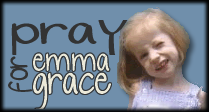Trisomy literally translates "three bodies". The term is used to refer to chromosomes that don't develop quite like chromosomes ordinarily do.
Humans usually have 23 pairs of chromosomes, with two sex chromosomes that decide gender and 44 chromosomes that dictate other factors, such as growth and function. A chromosome disorder is caused by an alteration in the number or genetic structure of chromosomes. Trisomy occurs when the affected person has 47 chromosomes instead of 46. One of the 23 chromosome positions has 3 chromosomes rather than the usual pair. The 3 most common trisomies occur at the 21st position, Trisomy 21, Down's Syndrome, the 18th position, Trisomy 18, Edward's Syndrome, and the 13th position, Trisomy 13, or Patau Syndrome.
Trisomy 18, Edward's Syndrome occurs in one out of every 3 to 6 thousand live births. Characteristis often include:
Defects of the kidneys, ureters, heart, lungs and diaphragm.
Gastrointestinal malformations.
Cleft lip or cleft palate.
Small skull (microcephaly).
Malformations of the hands and feet - including missing thumbs, club feet and webbing between the fingers and toes (syndactyly).
Neural tube defect, where the spinal cord, meninges and blood vessels protrude through a gap in the vertebrae (myelomeningocele).
Signs during pregnancy that there may be a problem may include:
Too much amniotic fluid surrounding the baby (polyhydramnios).
Only one umbilical cord artery.
A smaller than expected placenta.
The baby is small for its gestational age.
The baby is less active than expected.
Congenital defects, including cleft palate or heart abnormalities, are picked up during ultrasound scans.
I had covered this material during my obstetrics rotation in nursing school. I think the instructor may have spent 5 minutes on trisomy disorders, there were a couple paragraphs in the text, and possibly a question about the usual number of chromosome pairs on an exam. I had not, in any case, retained more than a vague notion of what trisomy meant. I knew it was somehow connected to Down's Syndrome, but the full impact of what it meant for my child to have Trisomy 18 didn't hit me when Dr Eberly first verbalized his concern that Mackenzie probably had this anomally.... It hit me about 20 minutes later, when I found the entry for Trisomy 18 in an old copy of the Merck Manual that was at the nurse's station in OB. Thumbing through the pages I came to the entry. I read the whole thing, big words and all. Then I came to the last two lines of the entry, and everything around me sped up while everything inside me came to a dead stop as I read:
More than 50% die within the 1st week; less than 10% are still alive at 1 year. Those who survive have marked developmental delay and disability. No specific treatment is available.
I remember that moment, reading those words, and feeling like what was happening must be happening to someone else.
Suddenly, instantly, all of our plans, all of our dreams, every detail we had so carefully considered, all of it vanished. My child would never march in her highschool band. I'd never see her in a dance recital. She'd never hike a mountain trail, or ride horseback on a beach, or make a snow-angel in the first snow of winter.
Mackenzie's birth had taken place, Michelle was writhing in discomfort as her epidural anesthesia wore off, and I had just learned that the child we had longed and prayed for had this prognosis.
Numb. Alone. Confused. Weak. Stupid.
Since we both worked at South Baldwin, our news was not our own, people from every department had been following our progress. Lab techs, nurses' aides, radiology staff, doctors, physical therapists, respiratory therapists, social workers, scrub techs, housekeepers, maintenance personel, administrators, and marketing specialists, all had an interest in the Lambert baby.



No comments:
Post a Comment